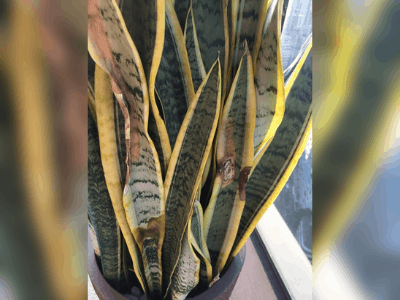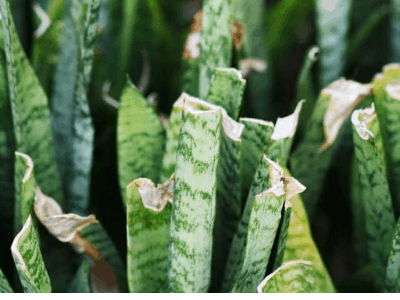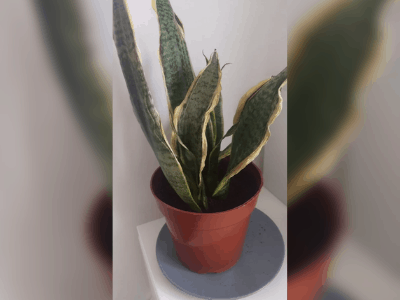
Snake plants are extremely easy to care for, making them very popular amongst homeowners.
Known also as a Snake Plant and Mother-in-Law’s Tongue this succulent has a reputation of being incredibly hardy.
Unfortunately, just like any other plant, snake plants can succumb to problems…
…causing you to scratch your head in confusion, trying to figure out…
…why your snake plant is dying and how to remedy it.
The first step in dealing with this problem is to recognize there is a problem in the first place.
The snake plant will begin to exhibit these symptoms if it is experiencing terminal conditions.
Here we have story of Sonya and his husband about having an experience saving her dying snake plant
Let us hear Sonya’s story
“My snake plant is dying,” I said to my husband. “Can you water it?”
I’m not sure what happened, but the snake plant has been looking progressively worse every day.
The leaves are turning brown at the edges and looks like they’re about to fall off.
I’ve left them alone for a few days now, which was probably something…
…that didn’t help too much in saving my snake plant from death.
But we still need to make sure that our houseplants don’t die on us!
“You know, there’s no point in trying to save plants if you’re just going to neglect them.”
My husband responded with a frustrated tone of voice.
“You should take better care of your plants or else, it will dies in a days.”
From that day, I have a promise to my self.
Don’t you ever again neglecting my own plans for a long long time.

To revive a dying snake plant it is important to replicate some of the conditions of its native environment by watering it correctly, ensuring that it is in a room warmer then 50°F and to locate it in an area of bright indrect light rather the full sun.
Mark Bennett, qualified professional landscape gardener for over 10 years
Here’s the interesting part…
The Sign of Dying Snake Plant
Leaves that appear soft and floppy are likely to indicate that the plants have been overwatered.
One of the most common problems many growers deal with is this.
Many of our customers have reported damp and wet potting soil and a foul smell emanating…
…from the pots as evidence that this is a problem.
Besides the leaves, excessive moisture will adversely affect your plant’s roots…
…turning them mushy and rusty brown. If this occurs, your plants are in trouble.
Leaves become crisp and brittle. This usually starts at the leaf tips and along the borders of the leaves.
It might be caused by too little water. The plant may develop small brown scars on its leaves…
…if it doesn’t thrive for no apparent reason. This is caused by a sap-sucking pest called scale insects.
You may also encounter a small white, fuzzy creature known as leaf-junction mite…
…that tends to hide out in leaf joints or in other crevices where it can go undetected by most gardeners.
It is also called mealy bug, and it is another sap sucking insect.
These are some of the most common pests that may be detrimental to your Snake Plant.
Another issue that can prove fatal is temperature control.
Although highly tolerant of hot temperatures, your Snake Plant doesn’t appreciate it if it gets too cold.
This is a likely cause when you feel the leaves are feeling damp and you’re certain the symptoms…
…do not result from overwatering.
The majority of the problems listed just will manifest themselves in the leaves…
…and the careful observer will be able to take action in time to prevent the problem from becoming disastrous.

Common Causes
Snake Plants are easy to take care of, making them a favorite houseplant for many…
…even those who are not exceptionally good at keeping plants alive.
Here is a guide to growing and caring for snake plants that covers everything you need to get started.
Even if you have a green thumb, following factors can still negatively affect your plants:
Next up….
Overwatered Can Create Dying Snake Plant
Regardless of how experienced you are with snake plants, there is a problem that occurs when you first get started.
Snake plants grow best in dry and semi-arid climates.
The leaves should be allowed to dry out between each watering. Yellowing leaves are an early warning sign.
In the following steps, the leaves progressively lose their elasticity and become mushy and wane.
Although you will initially see what is happening above ground…
…what is happening below ground is probably the most dangerous thing for the plant.
The roots will have begun to rot, and this means that the leaves are losing their ability to absorb…
…the minerals and nutrients they need.
The first step in removing your concern from your plant, if you believe it is due to over-watering…
…will be to confirm your diagnosis.
When checking your potting soil, make sure it doesn’t feel very damp or waterlogged.
That means your diagnosis is correct.
In cases where the plant is not too advanced, you may be able to recover…
…by stopping watering and allowing the potting soil to dry out.
You need to put drainage holes in the bottom of the container to clear any water.
Go On….
Make sure it will not float on water if there is no drainage hole in the bottom of the container.
You may allow the soil to dry completely, then allow several days for it not to be watered again.
Water the top of the soil for a few hours or overnight, until the soil is saturated…
…or the drainage holes are blocked.
Before placing the plant back into its plant saucer, let it drain away any remaining water.
Be sure to let the soil completely dry before watering again.
You can do this by pressing a finger into the soil until it reaches a depth of two inches.
There are new growths on your knuckles around your second knuckle.
You can repeat the watering method I’ve just mentioned if you’re sure the soil is dry.
Don’t go on an all-too-common watering schedule.
Different plants lose water at different rates depending on surrounding conditions…
…the time of year, and the size of the plant.
The best action you can take is to experiment with water and soil only after they become totally dry.
In extreme cases where root rot has become established…
…you should pull the plant out of its pot and eliminate any loose, damp soil surrounding the roots.
Next, take some secateurs and cut away any of the roots that have become brown and slimy.
Now lay the root ball on a sheet of newspaper and allow it to dry out for several days.
Only when you have dried the root ball well should you consider repotting your plant.
Pot the plant into a pot no larger than its original container using a free-draining potting mix…
…such as succulent or cactus mix.
If you reuse the original potting soil, even if it has become dry, clean the pot thoroughly before repotting.
Keeping the potting mix slightly damp should not cause any damage to your plant…
…so make sure you don’t rush to water it.
When the plants are completely dry, only then water them to help them adjust to their new environment.
Watering correctly is far more beneficial for snake plants than watering overly.
During the growing season, you are unlikely to need to water this plant more than once every two weeks.
The frequency of that may decrease as the dormant season approaches, and possibly to once a month…
…or even less often.
Accept the idea that judging whether or not to water will be best done by the sense of touching the soil.

Last but not least…
Underwatering
When you are not familiar with snake plants, the signs and symptoms of underwatering and overwatering may seem very similar.
The leaves will wilt, turn yellow, and have a general unhealthy appearance.
A big difference between underwatering and overwatering is that an under-watered plant does not have that mushy texture to its leaves.
Instead, they become crisper and more crumbly. The reason for their similarity is simple.
Plants in both situations will fail to transport the necessary nutrients to the plant’s leaves above ground.
A sure sign that the problem is caused by underwatering and not overwatering is the desiccated and dusty soil.
If the soil does not feel soily, then it is the result of underwatering.
It will bounce back quickly as soon as a sustainable watering regimen is introduced…
…to this plant since it is used to long periods without moisture.
As long as that happens, you can continue the same way that has just been applied.
The soil should not be so degraded that it doesn’t hold some moisture after watering.
You should think about repotting if either too much water flows straight through…
…or the soil becomes completely dry within hours.

Sum Up
See having Snake plant is good choice for you to have! It’s cool, its famous, it’s easy to have and care!
What else do you need? In this pandemic time like this, is a good choice for you to have an new activity…
…and having snake plant is a good choice for you to have!
Conclusion
Last thing for sure. This plant need to be care carefully, remember plant need the “love” too.
Alright that’s all for today! Do you have any questions about all of this?
Or do you want to add some method to save dying snake plant?
Let me know your recommendation from the comment below.
I hope you can now take care your snake carefully and grow it big!
Thanks for reading this article! Bye!
